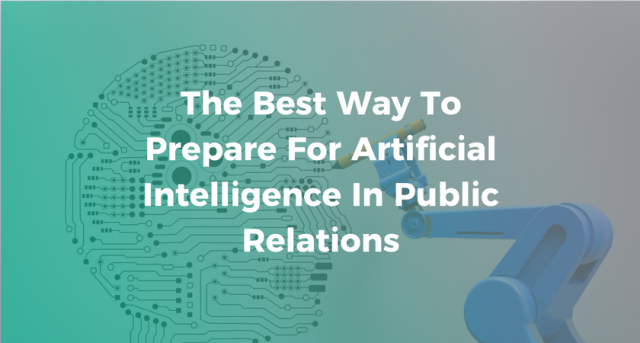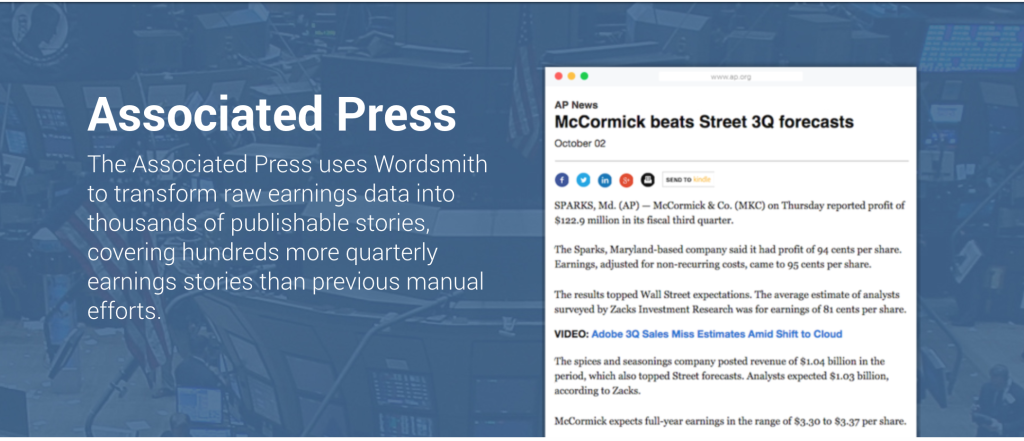With today’s consumer AI tools at your fingertips, it may feel like you don’t need a computer science degree to understand how artificial intelligence will bring value to the communications process.
“Siri, find me the top food and wine reporters . . . ranked in order from the outlet with the largest audience to the smallest . . . that prefers pitches via e-mail with phone call followup afterward . . . in the mid-Western U.S. . . . that we’ve never connected with before.”
Assuming that didn’t work for you, it brings up a larger point: While you don’t need a degree in computer science to build an AI strategy, it is important that PR pros don’t sit on the sidelines and let an AI strategy get defined for them without their input. In this post, we’ll go through some practical steps you and your team can do to get started.
The Industry Take On AI So Far
Today, most agency executives only seem to agree on what the limits of AI in PR will be. In a recent column on PRWeek, Ivan Ristic of Diffusion suggested that while AI might be good for data mining keywords across blogs and online publications to find trends for clients, it still won’t replace relationships that make the industry go-round.
“A bot can’t lay claim to emotional intelligence, a cornerstone of all PR work. Teams employing AI handling external communication would be wise to have plans to manage reputation should anything go awry,” he wrote. “Humans build trust with humans — not bots.”
You might be forgiven, however, if you wondered just how much AI could take on in the earned media capacity. When used effectively, machines can get smarter about how to book hotels, solve customer service issues, and much more. Is it really so difficult to imagine a bot that would generate pitch ideas for specific journalists? While some in the profession loathe to hear it, it’s not far-fetched.
The good news for comms pros: It will be a blend of both technology and human insight. Most experts suggest AI will augment that strategic thinking by synthesizing details the way marketing automation has done for other parts of the enterprise. This recent story on Ragan sums it up well:
“By taking advantage of massive quantities of data and using AI to draw insights on it, PR pros can now . . . cut through the clutter and find useful, relevant data, quantify buzz and press hits, properly attribute revenue, know which tactics are working, spot brand and revenue indicators and identify PR funnel accelerators.”
Comms pros don’t need to move immediately on changing their workflow for AI, but they would also be making a mistake to not prepare. Just as personal computers entered the workplace to reduce onerous paperwork and administrative tasks, there’s nothing wrong with taking baby steps with AI before PR professionals maximize its potential. In fact, a blogger on Towards Data Science suggested this is precisely the low-hanging fruit they should begin to pick:
“If you have an agency full of clients, you probably already realize how exhausting it is, engaging with the public on social media, liking, replying, following, searching all over again for every single account you manage daily,” she wrote. “How good it would be if every task could be automated, saving the time of PR professionals for vital tasks such as creative work and decision-making activities?
Maybe the best way to get started is by learning how technology experts are defining AI. According to market research firm Forrester, for example, there’s a big difference between “pure AI” — where machines literally think and reason the way humans do — and “pragmatic AI,” which is designed to learn the steps involved in doing specific tasks the way Siri looks up information online or, in its more advanced form, playing games like chess.
When we talk about pragmatic AI, we’re talking about a collection of technologies that include natural language processing and machine learning (algorithms that analyze information and try to predict what will happen).
The below video from PBS Digital Studios explains in detail the difference between automated machine learning and AI.
In a PR context, think of these two examples:
- An AI tool you could use to look through all the potential influencers (including non-professional journalists who simply have a large social media following). It could determine which ones will be receptive to a pitch and whose coverage would tie back to any of the client’s key performance indicators, including sales revenue.
- An AI tool you could use to “meet” with a new client to get a sense of their needs, their narrative, their culture and other factors. This tool would be able to answer questions about your firm in a way that inspires confidence and helps you land the account.
The first example is pragmatic AI. It represents the kind of value you can get when you pair good data with great technology. The second probably still feels unnerving, as this is where human insight and emotion is still very important for storytelling and campaign creation.
One day the PR industry may want and rely on both pure and pragmatic AI, but to make that call you need to understand how a machine actually learns.
Stages Of AI Supervision
Think about how we teach children in school. There is the classroom scenario where teachers are working directly with students to get across certain concepts. Then there is “independent study” — usually introduced as they get a little older — where they are given just enough information and instructions to experiment and figure out concepts on their own.
A lot of education also falls somewhere in between. A group of elementary children might be asked to learn their multiplication tables and solve a few problems, but are free to ask for help here and there. Machine learning in AI works much the same way.
In what’s called “supervised learning,” for instance, technology can use what it is given, or “training data,” to get from A to B on a particular task where you know exactly what the end result should be. Let’s use one of the simple PR tasks referenced earlier — social media duties — as an example. And let’s break down the tasks as if a human would still be doing them instead of a machine.
Let’s imagine you want to make headlines and rewrite them for social media in a way that highlights your client’s or brand’s role in the story. The next step might be copying and pasting the text with the URL in the field of a social networking service. Then it might be cross-referencing the right hashtags, including one created for a particular PR campaign, to include in the post that is known to get the most amount of pick up. Then you would be press “post.”
While most people have a person do this today, supervised learning algorithms with good training data, however, might be able to manage some social media promotion to scale some of your social media engagement. Now think of other tasks where AI could be put to work organizing work back schedules or even writing rough drafts of a press release based on your firm’s brand voice and guidelines. The Associated Press is already using AI to write earnings stories.
Source: Automated Insights Associated Press Case Study
Unsupervised learning doesn’t need training data but instead has the system learn on the fly. It tries to identify what the problem is, and the steps required to solve it. Imagine, for instance, you’ve created a microsite for a PR campaign that repurposes a library of blog posts, media mentions, and other assets. Unsupervised AI might figure out that, based on the dates of various files, that it should be organized in reverse chronological order on the microsite, or classify it in some other way based on the attributes of the information. It may not know the “right” answer with certainty, but it will work more like a human being in using whatever it can to make the best possible guess.
A more complex version of unsupervised machine learning might be able to look for clues about the sentiment of earned media coverage, sending alerts about negative stories the second they appear so PR professionals can respond more quickly. The technology might also become sophisticated enough to spot “fake news” or inaccuracies in the way a company operates, or nicknames for people and organizations that might otherwise get missed when looking for where a brand is being mentioned online. That might take “semi-supervised learning,” where PR or corporate comms professionals do some of the AI “training” and leave some aspects up to the machines.
Next Steps For AI And The PR Sector
A few months ago, PR consultant Steven Waddington took to his blog to chastise his peers for seemingly attempting to avoid the revolution unfolding before us.
“The impact of algorithms on discourse in the public sphere needs to be characterized and their creators held to account,” he wrote. “Public relations, like other professions, is sleepwalking into the issue of artificial intelligence. It’s an issue that is rarely addressed at events and by media in the business of public relations. That needs to change.”
In terms of how that change could take place, here are a few ideas:
- Seek out an AI advantage: Whether it’s high-end machine learning to solve big problems or just reducing some of the grunt work, begin brainstorming with your team, as well as though in other departments, on where AI might make sense as a pilot project.
- Lay the foundation for automation: The transition to AI-enabled processes will be much smoother for firms that have already gotten familiar with technologies that assist in areas that have traditionally been manual, error-prone or both. If you’re a data-driven PR shop, you may have a head start on what AI could do.
- Adopt a reporter’s mindset: The journalists you pitch are often infinitely curious — and highly skeptical — about what they see and hear. They ask a lot of questions to get at important details. They may even focus on the negative angle before they get to any “good news.” All of these behaviors and characteristics could serve PR professionals well as they learn more about AI and what it could do for them.
Finally, it may be best to think of AI as a member of the team you’re coaching, rather than a technology out to make traditional PR obsolete. In fact, if all goes as planned, AI may turn out to be one of your most valuable players.![]()









